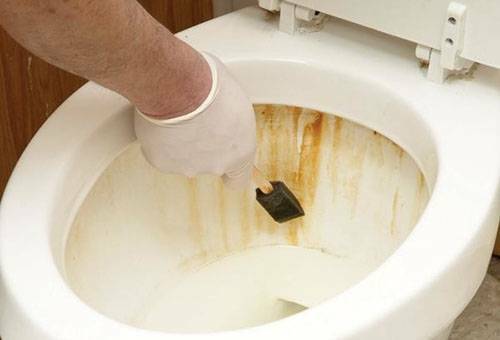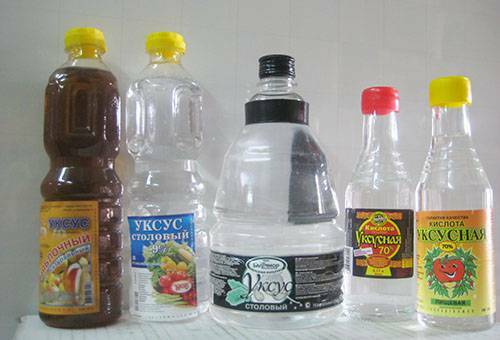Contents:
- Where does rust come from?
- How to remove rust?
- Household chemicals
- Popular recipes
- Small tricks
How to clean the toilet from rust? This question is asked by many mistresses who dream of preserving the cleanliness and pleasant appearance of plumbing fixtures in the bathroom.

Where does rust come from?
The causes of the appearance of rusty spots on the surface of the toilet bowl can be different. Often the fault is the chemical composition of the water. Rust is caused by an abundance of various iron salts in tap water. Fight with such a problem is possible - for this, special capsules or tablets should be added to the tank. They change the chemical composition of water, neutralizing harmful compounds, and also give the water a pleasant smell.
If the quality of tap water is not in doubt, then the source of rust can be old pipes made of non-galvanized steel. The output is either to add in the same way to the drain tank of the tablet, or to replace the pipes with polypropylene or metal-plastic pipes.
Appearance of spots, including rusty, contributes to the rough surface of the toilet, for which pollution "clings".This problem is typical for faience toilet bowls. But porcelain has a smoother surface, which gets dirty much less, and rust is less often removed from the toilet bowl.
Rusted traces are also guaranteed if the tank leaks and water flows out of it in a thin stream. Remove the rust from the toilet for a long time in this case will not work until the malfunction is eliminated.
In order not to do a regularly meaningless job of cleaning the surface of the toilet, it is worth trying to remove or minimize the causes of rust.
How to remove rust?
The whole wide range of anti-rust stain remedies can be divided into two large groups - folk and store.

Household chemical products
- Abrasive .This group includes all means whose cleansing action is based on the mechanical action of the powder particles on the contamination. An example of such a tool may well be the well-known "Pemolux".Such a tool should be applied to a rag or sponge and rub a rusty stain until it disappears completely. Although such a tool is effective in the end, removing stains takes a long time. In addition, small, sharp fragments of the powder scratch the surface, which means that later it will be easier to form dirt on it.
- Alkaline .They act by dissolving contamination without mechanical damage to the surface. Such funds are applied to the stain for 10-15 minutes, and then washed off with water. They are considered to be quite effective, but chronic pollution does not always manage to wash them off.
- Acidic .Like alkaline substances, such substances simply dissolve the contamination. Good to remove any kind of spots, even the oldest. But due to the high aggressiveness of such products, it is recommended to work with them at home in gloves, and also to avoid getting them on the exposed skin and eyes. Acids are excellent for faience and porcelain toilet bowls, but here it is not necessary to use them for enamel baths - they dissolve the enamel.
Advice
Do not mix several household chemicals - this can lead to unpredictable chemical reactions and damage to the surface of the toilet.

Traditional recipes
- Vinegar .The rag soaked in acetic essence is put on half an hour - an hour for the polluted site, after which this place is rinsed with water. Peroxide and ammonia .Mixed in a ratio of 1 to 10, these two substances are applied to the stain for several hours.
- Oxalic acid .The agent is applied to rust for about an hour, after which this place should be wiped with a sponge soaked in ammonia, and then rinsed abundantly with water.
- Hydrochloric acid .Rusty stain is filled with acid, left for a few minutes, rinsed with water.

Little tricks of
How to remove rust from the toilet, if there is no cleaner at hand?
- Remove small spots with toothpaste. It should be applied to a rusted area and brushed.
- It is believed that rust and calcareous deposits on sanitary ware can be washed with such drinks as "Cola", "Sprite", "Phantom", etc. You should moisten them with a rag and leave it on for a while, then rinse itplace with water.
- Well copes with spots electrolyte from batteries, although this is not its main purpose. The liquid is applied to the stain for a quarter of an hour, and then washed off.
In order for the plumbing to glisten and pleases the eye with whiteness, it is necessary to timely eliminate all its breakdowns and conduct regular cleaning. It is quite obvious that the newly appeared pollution is much easier to clean than stale old stains. And when buying plumbing is to give preference to devices with a special water-repellent glaze, which will prevent the appearance of contaminants.
